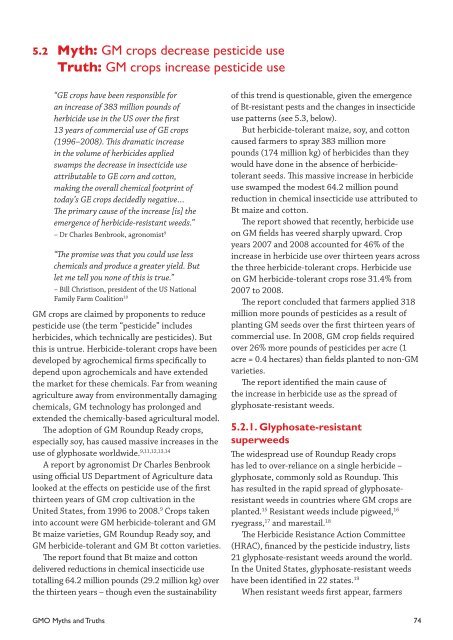GMO Myths and Truths
GMO Myths and Truths
GMO Myths and Truths
You also want an ePaper? Increase the reach of your titles
YUMPU automatically turns print PDFs into web optimized ePapers that Google loves.
5.2 Myth: GM crops decrease pesticide use<br />
Truth: GM crops increase pesticide use<br />
“GE crops have been responsible for<br />
an increase of 383 million pounds of<br />
herbicide use in the US over the first<br />
13 years of commercial use of GE crops<br />
(1996–2008). This dramatic increase<br />
in the volume of herbicides applied<br />
swamps the decrease in insecticide use<br />
attributable to GE corn <strong>and</strong> cotton,<br />
making the overall chemical footprint of<br />
today’s GE crops decidedly negative…<br />
The primary cause of the increase [is] the<br />
emergence of herbicide-resistant weeds.”<br />
– Dr Charles Benbrook, agronomist 9<br />
“The promise was that you could use less<br />
chemicals <strong>and</strong> produce a greater yield. But<br />
let me tell you none of this is true.”<br />
– Bill Christison, president of the US National<br />
Family Farm Coalition 10<br />
GM crops are claimed by proponents to reduce<br />
pesticide use (the term “pesticide” includes<br />
herbicides, which technically are pesticides). But<br />
this is untrue. Herbicide-tolerant crops have been<br />
developed by agrochemical firms specifically to<br />
depend upon agrochemicals <strong>and</strong> have extended<br />
the market for these chemicals. Far from weaning<br />
agriculture away from environmentally damaging<br />
chemicals, GM technology has prolonged <strong>and</strong><br />
extended the chemically-based agricultural model.<br />
The adoption of GM Roundup Ready crops,<br />
especially soy, has caused massive increases in the<br />
use of glyphosate worldwide. 9,11,12,13,14<br />
A report by agronomist Dr Charles Benbrook<br />
using official US Department of Agriculture data<br />
looked at the effects on pesticide use of the first<br />
thirteen years of GM crop cultivation in the<br />
United States, from 1996 to 2008. 9 Crops taken<br />
into account were GM herbicide-tolerant <strong>and</strong> GM<br />
Bt maize varieties, GM Roundup Ready soy, <strong>and</strong><br />
GM herbicide-tolerant <strong>and</strong> GM Bt cotton varieties.<br />
The report found that Bt maize <strong>and</strong> cotton<br />
delivered reductions in chemical insecticide use<br />
totalling 64.2 million pounds (29.2 million kg) over<br />
the thirteen years – though even the sustainability<br />
of this trend is questionable, given the emergence<br />
of Bt-resistant pests <strong>and</strong> the changes in insecticide<br />
use patterns (see 5.3, below).<br />
But herbicide-tolerant maize, soy, <strong>and</strong> cotton<br />
caused farmers to spray 383 million more<br />
pounds (174 million kg) of herbicides than they<br />
would have done in the absence of herbicidetolerant<br />
seeds. This massive increase in herbicide<br />
use swamped the modest 64.2 million pound<br />
reduction in chemical insecticide use attributed to<br />
Bt maize <strong>and</strong> cotton.<br />
The report showed that recently, herbicide use<br />
on GM fields has veered sharply upward. Crop<br />
years 2007 <strong>and</strong> 2008 accounted for 46% of the<br />
increase in herbicide use over thirteen years across<br />
the three herbicide-tolerant crops. Herbicide use<br />
on GM herbicide-tolerant crops rose 31.4% from<br />
2007 to 2008.<br />
The report concluded that farmers applied 318<br />
million more pounds of pesticides as a result of<br />
planting GM seeds over the first thirteen years of<br />
commercial use. In 2008, GM crop fields required<br />
over 26% more pounds of pesticides per acre (1<br />
acre = 0.4 hectares) than fields planted to non-GM<br />
varieties.<br />
The report identified the main cause of<br />
the increase in herbicide use as the spread of<br />
glyphosate-resistant weeds.<br />
5.2.1. Glyphosate-resistant<br />
superweeds<br />
The widespread use of Roundup Ready crops<br />
has led to over-reliance on a single herbicide –<br />
glyphosate, commonly sold as Roundup. This<br />
has resulted in the rapid spread of glyphosateresistant<br />
weeds in countries where GM crops are<br />
planted. 15 Resistant weeds include pigweed, 16<br />
ryegrass, 17 <strong>and</strong> marestail. 18<br />
The Herbicide Resistance Action Committee<br />
(HRAC), financed by the pesticide industry, lists<br />
21 glyphosate-resistant weeds around the world.<br />
In the United States, glyphosate-resistant weeds<br />
have been identified in 22 states. 19<br />
When resistant weeds first appear, farmers<br />
<strong>GMO</strong> <strong>Myths</strong> <strong>and</strong> <strong>Truths</strong> 74


